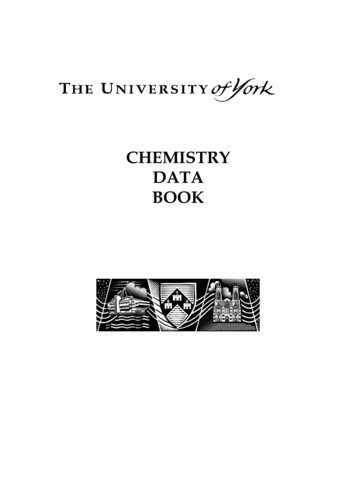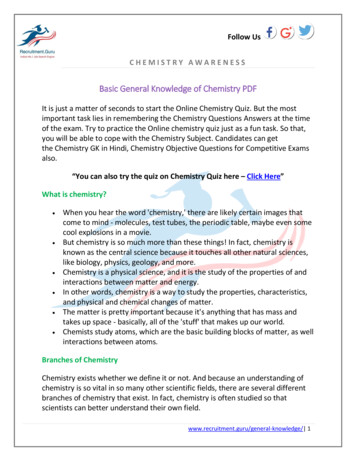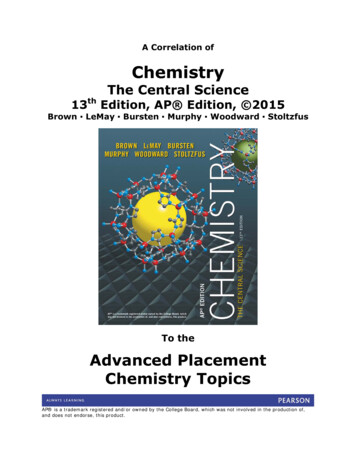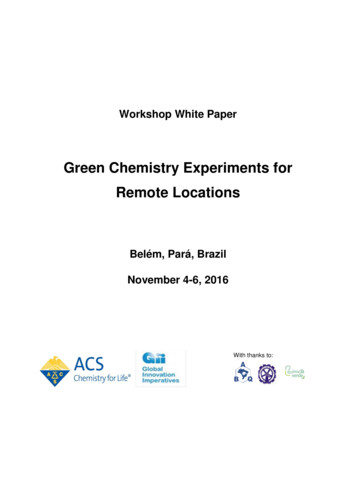
Transcription
CHEMISTRYDATABOOK
October 2011INTRODUCTIONThis Data Book contains a selection of information and datawhich is relevant to the Chemistry Courses at York.As far as thermal data is concerned there are often variationsin the values cited in the literature. In these instances, oneparticular set of values has been chosen for display in thetables and, under normal circumstances, no special problemsshould arise on account of this choice. For precise work,however, it is advisable to consult the extensive tabulationsof source material that are available in the Morrell andWhinfield Libraries. The most valuable of these is:CRC Handbook of Physics and ChemistryEd. R C WestA useful compilation and summary of SI conventions isfound in Quantities, Units and Symbols in PhysicalChemistry, Mills et. al., Blackwell (1989).D K SmithOctober, 2011
CONTENTSPageIntroductionPeriodic TableGreek AlphabetBack Page11 Atomic and Ionic PropertiesAtomic First Ionisation EnergiesElectron-Gain EnergiesEnthalpies of Formation of Gaseous Monatomic CationsIonic Radii (Shannon-Prewitt)Slater Atomic Radii & Allred-Rochow ElectronegativesStandard Half-Cell Reduction Potentials23114682 Thermal Properties of MatterHeats of CombustionProperties of Selected Organic CompoundsStandard Enthalpies of Fusion and VaporisationStandard Enthalpies of HydrationStandard Enthalpies of Hydration of IonsSteam - Temperature, Pressure & VolumeThermal Properties of Liquid WaterThermodynamic Data for Inorganic CompoundsThermodynamic Data for Organic Compounds2124121313262714223 EnergyEnergy EquivalentsApproximate Energy Conversion Factors28294 Terrestrial DataAtmosphereEarthGeological Time ScalesUnited Kingdom Land Statistics31303231
5 Physical and Chemical Properties and Data1H NMR Chemical Shifts13C NMR Chemical ShiftsAmino AcidsBravais LatticesCommon AbbreviationsGenetic CodeHammett Substituent ConstantsInfra-red Absorption Frequencies for Inorganic SpeciesInfra-red Absorption Frequencies for Organic FunctionsMohs’ Hardness ScaleNMR Properties of Single IsotopesOrder of Precedence for Common Groups – Table AOrder of Precedence for Common Groups – Table BPhysical Properties of GasesPhysical Properties of LiquidsPhysical Properties of Some Solid MaterialspKA approximate values of Selected Organic CompoundsSelected Stability ConstantsStokes’ Law of ViscosityStructures of Selected Cyclic Organic CompoundsStructures of Selected Organic CompoundsStructures of Selected Organic GroupsSummary of organic Nomenclature 0516 Mathematical DataArithmetical ProgressionAssigning a Molecule to its Point GroupBionomial SeriesCharacter Tables for Selected GroupsComplex NumbersCritical Values for F for a One-tailed TestDefinitions of Binomial SeriesDerivatives and Indefinite IntegralsDirect Product Rules for Chemically Important GroupsFactorial DefinitionsGeometrical ProgressionGroup Theoretical Formulae896687678695878882878981
Hyperbolic FunctionsIntegration by PartsMaclaurin SeriesNormal Distribution (Single Sided)Probability Points of the 2 DistributionQuadratic EquationsScalar, Vector ProductsSimpson’s RuleStudents’ t-DistributionTaylor SeriesTolerance IntervalsTrapezoidal RuleTrigonometrical Formulae and Results7 Units and ConstantsAtomic UnitsFundamental ConstantsMultiples of Base 10SI Units8685899698868985928994859010199101100
GREEK ALPHABETAlpha Nu Beta Xi Gamma Omicron Delta Pi Epsilon Rho Zeta Sigma Eta Tau Theta Upsilon Iota Phi Kappa Chi Lambda Psi Mu Omega
ATOMIC FIRST IONIZATION ENERGIES 6.0Am6.0
ELECTRON-GAIN ENERGIES Uo / kJ mol 1PERIODIC TABLE ARRANGEMENTLi 59.8B 17.3C 122.3N20.1O 141.1F 328.0Na 52.2Al 44Si 133.6P 72S 200.4Cl 348.8K 45.4Cu 118Ge 115As 77Se 195.0Br 324.6Rb 46.9Ag 125.7Sn 120Sb 100Te 190.2I 295.4Cs 45.5Au 222.8
IONIC RADII(in pm - after Shannon and Prewitt)The values given are applicable to oxides and fluorides (c.n. 6, based on the value 140 pm for 6-coordinated O2-).Radii for other c.n’s are given in the Notes below, and the values for species enclosed in the “box” gives anappropriate idea of the sizes of these ions.(A) Non-transition MetalsOxidation 1F(d)133Cl180Br195I220OH–155SH–200 1Li(a)74Na102K138Rb149Cs170Tl150NH4 150 9La115Ti61Zr80 3 4Pb118
(B) Transition MetalsOxidation State 2Low spinHigh spinLow spinHigh spin 3Notes: NiCu6973625865556555615660-c.n. 4, 59 pmc.n. 4, 27 pmc.n. 2, 135 pm; c.n. 8, 142 pmM-F is at least 10 pm greater than M-O in ScOF and YOFc.n. 8, 142 pm; c.n. 12, 160 pm(See Wells, p. 404, 4th edn).SINGLE BOND COVALENT RADII (in Br114Sn140Sb143Te135I133
SLATER ATOMIC RADII AND ALLRED-ROCHOW ELECTRONEGATIVITIESData are given in the form:Atom Radius/pmElectronegativityH 532.20Li 1450.97Be 1051.47B 852.01Na 1801.01Mg 1501.23Al 1251.47Si 1101.74P 1002.0S 1002.44Cl 1002.83K 2200.91Ca 1801.04Ga 1301.82Ge 1252.02As 1152.20Se 1152.48Br 1152.74Rb 2350.90Sr 2000.99In 1551.49Sn 1451.72Sb 1451.82Te 1402.01I1402.21Cs 2600.86Ba 2150.97Tl 1901.44Pb 1801.55Bi 1601.67Po 1901.76At1.90Fr0.86Ra 2150.97C702.50N653.07O603.50F504.10Ac 1951.00.Sc 1601.20Y1801.11Ti 1401.32V 1351.45Cr 1401.56Mn 1401.60Fe 1401.64Co 1351.70Ni 1351.75Cu 1351.75Zn 1351.66Zr 1551.22Nb 1451.23Mo 1451.30Tc 1351.36Ru 1301.42Rh 1351.43Pd 1401.35Ag 1601.42Cd1551.46
La 1951.08Hf 1551.23Ta 1451.33W 1351.40Re 1351.46Os 1301.52Ir 1351.55Pt 1351.44Au 1351.41Hg 1501.44.Ce 1851.08Pr 1851.07Nd 1851.07Pm 1831.07Sm 1851.07Eu 1851.01Gd 1801.11Tb 1751.10Dy 1751.10Ho 1751.10Er 1751.11Tm 1751.11Yb 1751.06Lu 1751.14.Th 1801.11Pa 1801.14Notes:U 1751.22Np 1751.22Pu 1751.22Am 1751.2(1)The Electronegativities are taken from Table 4.8 of Inorganic Chemistry,by J E Huheey - see also A L Allred and E G Rochow, J. Inorg. Nucl. Chem., 5, 264 (1958)and E J Little and M M Jones, J. Chem. Educ., 27, (1960) for original calculations.(2)The Atomic Radii are taken from Table 3-1 in Quantum Theory of Molecules andSolids by J C Slater (vol 2).
TABLE OF STANDARD HALF-CELL REDUCTION POTENTIALSHalf-cell reduction potentials in aqueous acid (aH 1.0) solutions at 298.15 K (25oC) (after W.M. Latimer).Oxidised/Reduced Specieso /VE—Ag /Ag 0.7991Ag2 /Ag 1.98AgCl/Ag, Cl–Oxidised/Reduced Specieso /VE—K /K–2.925 0.222La3 /La–2.37Al3 / Al–1.66Li /Li–3.045Au /Au 1.68Au3 / Au 1.50Mg2 /Mg–2.37Mn2 /Mn–1.18Ba2 /Ba–2.90Mn3 /Mn2 1.51Be2 /Be–1.85MnO 4 / MnO42 0.564Br2( )/2Br– 1.0652MnO 4 8H /Mn2 , 4H2O 1.51MnO42 , 4H /MnO2, 2H2O 1.695Ca2 /Ca–2.76Cd2 /Cd–0.403Na /Na–2.711Cl2/2Cl– 1.3595Ni2 /Ni–0.250continued .
Oxidised/Reduced Specieso /VE—Oxidised/Reduced Specieso /VE—Co2 /Co–0.277O2, 2H /H2O2 0.682Co3 / Co2 1.82O2, 4H /2H2O 1.229Cr3 /Cr–0.74O3, 2H /O2, H2O 2.07Cr3 /Cr2 –0.41OH, H /H2O 2.8Cr2O72- ,14H /2Cr 3 ,7H 2O 1.33Cs /Cs–2.923Pb2 /Pb–0.126Cu /Cu 0.521PbO2, 4H /Pb2 , 2H2O 1.455Cu2 /Cu 0.337Cu2 /Cu 0.153Ra2 /Ra–2.92Rb /Rb–2.925F2/2F– 2.87F2, 2H /2HF (aq) 3.06S2O82- /S2O42- 2.01Fe2 /Fe–0.409Sc3 /Sc–2.08Fe3 /Fe2 0.771Sn2 /Sn–0.136Sn4 /Sn2 0.15Sr2 /Sr–2.89Ga3 /Ga–0.53continued .
TABLE OF STANDARD HALF-CELL REDUCTION POTENTIALS (continued)Oxidised/Reduced Specieso /VE—Oxidised/Reduced Specieso /VE—2H /H20.00Ti2 /TiH /H(g)–2.10Ti3 /Ti2 1H2/H–2–2.25(TiIV)2 , 2H /Ti3 , H2OTiO2 4H Ti 2H2O 0.10.86H3BO3, 3H /B 3H2O–0.87Tl /Tl–0.3363H2O2, H /OH , H2O 0.72Tl3 /Tl 1.25H2O2, 2H /2H2O 1.77Hg22 /2Hg 0.789V2 /V2Hg2 /Hg22 0.905V3 /V2 –0.255VO2 , 2H /V3 , H2O 0.337U3 /U–1.8Zn2 /Zn–0.763I2/2I– 0.5355I3 /3I 0.536In3 /In–0.342–1.63c –0.37c –1.18
ENTHALPIES OF FORMATION OF GASEOUS MONATOMIC CATIONS, H fo /(kJ mol 1 )H 1537Li 687Na Be2 2994Mg2 611K 2349Ca2 Al3 5484Sc3 51419264651Rb 495Cs 461Fr 463Sr2 1790Ba2 1661Ra2 1660Y3 4218La3 3896Ti2 2451Ti3 V2 2590V3 Cr2 2654Cr3 Mn2 2520Mn3 Fe2 2751Fe3 Co2 2842Co3 Ni2 2932Ni3 Cu 1090Cu2 51105425564757755715608063323054Ag 1019Ag2 3100Au 1262Zn2 2783Cd2 2623Hg2 2890Ga 871Ga3 5824In 808In3 Sn2 2435Sn4 5348Tl 9321Pb2 778Tl3 2373Pb4 56409550Sb3 5149Bi3 5005
STANDARD ENTHALPIES OF FUSION AND VAPORIZATION ATTHE TRANSITION TEMPERATURE trsH o / ( kJ mol 1 .805.58698.016.82012.680.23Inorganic 4.603528.1830.014.730.828.8551.5135.2737.99 at 298K43.530.0025.23 s26.7440.63644.016 at298K18.67Organic 9.85278.61178354175.2C2H5OH158.7
STANDARD ENTHALPIES OF HYDRATION AT INFINITEΔ hyd H o /(kJ mol-1 )DILUTIONLi Na K Rb Cs 856-742-658-637-613l--815-701-617-596-572Entries refer to X (g) Y-(g) X (aq) Y-(aq).Data: Principally J.O'M. Bockris and A K N Reddy, ModernElectrochemistry, Vol 1 Plenum Press, New York (1970)STANDARD ION HYDRATION ENTHALPIESΔ hyd H o /(kJ mol-1 ) at 298 KCationsH Li -1090Ag -464-520NH 4-301Na K -405Rb Cs -300-321-277Mg2 Ca2 -1920Sr2 Ba2 -1480Fe2 Cu2 -1950Zn2 Al3 -2050Fe3 -4430-1650-1360-2100-4690AnionsOHF--460-506Cl- -364Br- -337Entries refer to X (g) X (aq) based on H (g) H (aq)Data: Principally J.O'M. Bockris and A K N Reddy, ModernElectrochemistry, Vol 1 Plenum Press, New York (1970)I- -296
THERMODYNAMIC DATA FOR ELEMENTS AND INORGANIC COMPOUNDS (all values are for 298K).M/(g mol 1)oΔ f H /(kJmol )o-1Δ f G o /(JK mol-1 )§Sm f / (JK -1mol-1 ) §oCp.m /(JK -1mol-1 )ArgonAr(g)BromineBr2(l)Br2 79.9179.9190.920 30.907 111.88-219.07-121.55-36.40Carbon (for organic compounds, see Organic Table)C(s) (graphite)12.0110C(s) (diamond)12.011 1.895C(g)12.011 44.010-413.80HCN(g)27.03 135.1HCN(l)27.03 108.8726.02 150.6CN-(aq)0 154.84 20.7860 3.110 82.396 152.23 245.46 173.02 75.689 36.02 20.786-103.96-53.45 82.4 198.70-141.8 29.1420 2.900 671.26-137.17-394.36-385.98 124.7 124.97 172.4 5.740 2.377 158.10 197.67 213.74 117.6 201.78 112.84 94.1 8.527 6.113 20.838 29.14 37.11 35.86 70.63
Inorganic continued mol 1)oΔ f H /(kJmol )o-1o-1Δ f G /(JK mol )§Sm f / (JK -1mol-1 ) §oCp.m /(JK -1mol-1 )70.9135.4535.4535.4536.4636.460 121.68-233.13-167.16-92.31-167.160 105.68 223.07 165.20 33.91 21.840-131.23-95.30-131.23 56.5 186.91 56.5-136.4 29.12-136.463.5463.5463.5463.54143.0879.540 338.32 71.67 64.77-168.6-157.30 298.58 49.98 65.49-146.0-129.7 33.150 166.38 40.6-99.6 93.14 42.63 24.44 20.790 3.44-233.11-241.86 144.96 143.80 198.34 75.94 199.51 79.29 29.20 29.196 34.27 84.35 33.81CopperCu(s)Cu(g)Cu (aq)Cu2 (aq)Cu2O(s)Cu(O(s) 63.64 0283.02220.02820.02819.02219.022
Inorganic continued .01mol 1)oΔ f H /(kJmol )o-1o-1Δ f G /(JK mol )§Sm f / (JK -1mol-1 ) §oCp.m /(JK -1mol-1 )0 78.99-332.63-271.10 61.91-278.79-273.2 202.78 158.75-13.8 173.78 31.30 22.74-106.729.1300 126.15 20.7860 203.250 130.684 114.710 28.824 20.7840-285.83-241.82-187.78-237.13-228.57-120.35 37.99 69.91 188.83 109.6 75.291 33.58 89.1253.81253.810 62.440 19.33 116.135 260.69 54.44 36.90126.90126.90127.91 106.84-55.19 26.48 70.25-51.57 2.13 180 .79 111.3 206.59 20.786-142.3 29.158HeliumHe(g)4.003Hydrogen (see also deuterium)H2(g)2.016H(g)1.008 1.008H (aq)1.008H 15I2(s)I2(g)I(g)I-(aq)HI(g)0 217.970 1536.20Iodine
Inorganic continued .M/(gIronFe(s)Fe(g)Fe2 (aq)Fe3 (aq)Fe3O4(s)(magnetite)Fe2O3(s)(haematite)mol 1)oΔ f H /(kJmol )o-1o-1Δ f G /(JK mol )§Sm f / (JK -1mol-1 ) §oCp.m /(JK -1mol-1 )55.8555.8555.8555.85231.540 416.3-89.1-48.5-1118.40 370.7-78.90-4.7-1015.4 27.28 180.49-137.7-315.9 146.4 25.10 25.68 143.43159.69-824.2-742.2 87.40 103.8583.8000 164.08 20.7866.946.946.940 159.37-278.490 126.66-293.31 29.12 138.77 13.4 24.77 20.79 68.620.1800 146.33 20.786KryptonKr(g)LithiumLi(s)Li(g)Li (aq)NeonNe(g)
Inorganic continued (aq)mol 1)oΔ f H /(kJmol )o-1o-1Δ f G /(JK mol )§Sm f / (JK -1mol-1 ) §oCp.m /(JK -1mol-1 453.490 472.70 90.25 82.05 6-314.430 455.56 86.55 104.20 -202.87 191.61 153.30 210.76 219.85 240.06 155.60 146.4 146.4 192.45 111.3 113.4 151.08 94.6 29.125 20.786 29.844 38.45 37.20 109.87-86.6-86.6 17.0070 242.17 142.7-229.990 231.73 163.2-157.24 205.138 161.06 238.93-10.75 29.355 21.912 39.20-148.5NO 3 (aq) 79.9 84.1
Inorganic continued .M/(gPhosphorusP(s, wh)P(g)P2(g)P4(g)PH3(g)PCl3(g)PCl3(l)mol 1)oΔ f H /(kJmol )o-1o-1Δ f G /(JK mol )§Sm f / (JK -1mol-1 ) §oCp.m /(JK -1mol-1 )30.9730.9761.95123.9034.00137.33137.330 314.64 144.3 58.91 5.4-287.0-319.70 278.25 103.7 24.44 13.4-267.8-272.3 41.09 163.19 218.13 279.98 210.23 311.78 217.1 23.840 23.840 32.05 67.15 37.11 010 89.24 514.26-252.38-424.76-576.27-436.75-393.80-327.900 60.59 64.18 160.336 29.58 20.786-283.27-379.08-537.75-409.14-380.66-324.89 102.5 78.9 66.57 82.59 95.90 106.32 21.8 64.9 49.04 51.30 52.30 52.93PotassiumK(s)K(g)K (g)K (aq)KOH(s)KF(s)KCl(s)KBr(s)Kl(s)
Inorganic continued .M/(g mol 1)oΔ f H /(kJmol )o-1Δ f G o /(JK mol-1 )§Sm f / (JK -1mol-1 ) §oCp.m /(JK -1mol-1 )SiliconSi(s)Si(g)SiO2(s, )28.0928.0960.090 455.6-910.940 411.3-856.64 18.83 167.97 41.84 20.00 22.25 44.4322.9922.9922.9940.0058.44102.90149.890 107.32-240.12-425.61-411.15-361.06-287.780 76.76-261.91-379.49-384.14-384.98-286.06 51.21 153.71 59.0 64.46 72.13 86.82 98.53 28.24 20.79 46.4 59.54 50.50 51.38 52.0932.0632.0632.0664.0680.060 0.33 33.1-296.83-395.720 0.1 85.8-300.19-371.06 31.80 32.6-14.6 248.22 256.76 22.64 23.6SodiumNa(s)Na(g)Na (aq)NaOH(s)NaCl(s)NaBr(s)NaI(s)SulfurS(s, )(rhombic)S(s, )(monoclinic)S2-(ag)SO2(g)SO3(aq) 39.87 50.67
HEATS OF COMBUSTIONHeat of Combustion at 298 K(25oC)/kJ mol-1CompoundFormulaH2O(l) CO2(g)H2O(g) )394(32.8)Carbon .7)––EthanalC2H4O1167(26.5)––Ethanoic ��–PhenolC6H6O3054(32.5)––The left- and right- columns of values represent gross and nett calorific valuesrespectively; the values in brackets are the corresponding heats of combustionmeasured in MJ kg 1.
THERMODYNAMIC DATA FOR ORGANIC COMPOUNDS (ALL VALUES ARE FOR 298K).ooM/(g mol-1) t H o /(kJmol 1 )C(s) graphiteC(s) diamondCO2(g)12.01112.01144.0410 1.895-393.510 2.900-394.365.7402.377213.74HydrocarbonsCH4(g) methaneCH3(g) methylC2H2(g) ethyneC2H4(g) etheneC2H6(g) ethaneC3H6(g propeneC3H6 (g) cyclopropaneC3H8 (g) propaneC4H8 (g) 1-buteneC4H8 (g) Z-2-buteneC4H8 (g) E-2-buteneC4H10(g) butaneC5H12 (g) pentaneC5H12 (l)C6H6(l) benzeneC6H6 (g)C6H12 (l) cyclohexaneC6H5CH3 (g) 1692.1492.14-74.81 145.69 226.71 52.26-84.68 20.42 53.30-103.85-0.13-6.99-11.17-126.15-146.44-173.1 49.0 82.93-156-198.7 50.5-50.72 147.92 209.20 68.15-32.82 62.78 104.45-23.49 71.39 65.95 45120.2 124.3 129.72 26.8173.3269.31204.4204.3320.7136.181.67156.5Δ t G o /(JK m ol -1 ) § 122.0Sm t /(JK -1mol-1 )§C p.m /(JK -1mol-1 )8.5276.11337.11103.6
ooM/(g mol-1) t H o /(kJmol 1 )Alcohols and PhenolsCH3OH(l) methanolC5H5OH(l) ethanolC6H5OH(s) 74.78-50.9126.8160.7146.081.6111.46Carboxylic acidsHCOOH(l) formicCH3COOH(l)aceticCH3COOH(aq)(COOH)2(s) oxalicC6H5COOH(s) 33 32.16104.60243.41Nitrogen CompoundsCO(NH2)2(s) ureaCH2NH2(g) methylamineΔ t G o /(JK m ol -1 ) §Sm t /(JK -1mol-1 )§C p.m /(JK -1mol-1 )117146.893.1453.1
PROPERTIES OF SELECTED ORGANIC COMPOUNDSMelting PointTm/KBoiling PointTb/KDensity* /kg m-3(at 293 K)Enthalpy offormation *§ H / kJ molofBenzeneBenzoic AcidBromomethaneButaneButanoic anoic 2342316879126616765799589167799621327749783545 1049789567§§7146386602279State 1 �291–192–85lsgllgllllgg–485–278 52llg–280 227–224–199–8lglll
Melting PointTm/KBoiling PointTb/KDensity* /kg m-3(at 293 K)Enthalpy offormation *§ H / kJ lPropanoic 1,4-Dimethylbenzene* At 298 K; At 111.5 25286338250384261399309231decomp. 414371329226350335417412411§ A negative sign means evolution of heat; At 184 K423 1**At 453 K§§ At 104 KState 1–75g–239–184 12–135–250–173–105–104–509–302–217 20–136–134 79 72 75lglgllgllllglllll
TEMPERATURE, PRESSURE AND VOLUME RELATIONSHIPOF SATURATED )(250)(275)(300)(325)(350)(374)Critical pointPressureP/bar** .539.859.585.9121165221** 1 bar 105 N m–2Specific volumeV/m3 5000.03270.02160.01420.00880.00316
THERMAL PROPERTIES OF LIQUID WATER(AT 1 ATMOSPHERE PRESSURE)TemperatureT/K(oC)*Density /kg m-3Specific HeatCapacityCp/J kg-1 K-1Specific LatentHeat ofVaporisation /kJ kg-1 8*423(150)916.9*448(175)892.4*473(200)864.5*At appropriate pressure - see Table pertaining to steam.2400235323072260
TABLE OF ENERGY EQUIVALENTSEnergy associatedwithJl Joule (J)1eV6.242 10181calories0.2390kW h2.778 10–7Hz5.034 10227.244 1022J mol-16.022 10238.066 1031.160 1049.649 1046.317 10332.107 10233.030 10232.520 10225.432 10391.812 10292.608 10292.168 10281.509 10331 eV1.602 10–193.829 10-20 4.450 10-26 2.418 10141 calorie4.1842.612 10171 kilowatt-hour(kW h)3.600 1062.2247 10251 Hertz (Hz)6.262 10–34 4.136 10–15 1.583 10361 reciprocalcentimetre1.986 10–23 1.240 10–44.747 10–24 5.517 10–30 2.997 10101 Kelvin (K)1.381 10–23 8.620 10–53.301 10241 Therm1.055 10811.162 10–68.604 10511.841 10–4013.836 10–30 2.084 1010cm-1K3.336 10–11 4.800 10–1111.4396.952 1013.990 10–101.196 10118.3161APPROXIMATE VALUE OF AN EINSTEIN /nm200300400500600700Nh /kJ mol-1 600400300240200170
APPROXIMATE ENERGY CONVERSION FACTORSTo convert from one fuel/unit (down the left hand side) to another,(across the top of the Table) multiply by the factor shown:e.g. 1 t oil eq 397 therms 11.63 MW h 41.87 GJFrom To t oil eqt oil eq11032.52thermsMW hGJ39711.6341.87100029.3105.5thermsMW hTJ0.08623.934.1948012783.6010001 t oil equivalent is a unit of energy, defined as the gross calorific valueof a notional grade of crude petroleum.Conversions between any of therms, MW h and GJ are precise(independent of assumptions about fossil fuels).The calorific value of coal varies with its source/quality. The grosscalorific value of coal burned in the UK is typically between 25 - 30 GJ t-1.For electricity generated (MW h) from fossil fuels you need to take intoaccount the calorific value of the fuel and the thermal efficiency of conversion.For conversions between J and eV, see Table of Energy Equivalents.For conversions between mass and energy, E mc2,1 amu 931.5 MeV
THE EARTHRadius (mean)(polar)(equatorial) 6371 km6357 km6378 kmSurface area 5.1 1014 m2Greatest height (Mt Everest)Greatest depth (Mariana Trench) Land area 8848 m11020 m150 106 km2Ocean area Volume Mass Density (meanGravitational acceleration, g at surface (mean) (polar) 360 106 km21.08 1021 m35.98 1024 kg5520 kg m–39.81 m s–29.85 m s–29.75 m s–2g/m s–2 9.80616 - 0.025928 cos 2 0.000069 cos2 2 - 0.000003hwhere is the latitude and h the height above sea-levelMoment of inertia about axis of rotation 8 1037 kg m2(equatorial) Velocity (escape, at surface) (rotational, at equator)Solar flux (mean) 11 km s–10.4 km s–1 1.40 kW m–2
UK LAND STATISTICSTotal area24.8 1010 m2Urban3.5 1010 m2Water or river0.3 1010 m2Woodland2.0 1010 m2Rough Grazing6.7 1010 m2Arable4.9 1010 m2Temporary grass2.4 1010 m2Permanent grass5.0 1010 m21 ha 104 m2 2.47 acresTHE ATMOSPHEREComposition of dry air (by volume) :N2 (78%); O2 (21%); Ar (0.93%); CO2 (0.037%);Ne, He, CH4, Kr, H2, N2O, Xe, Rn (all in very smallamounts - total 0.003%)The moisture content of 100% humidity air:0.60% at 0oC1.20% at 10oC1.68% at 15oC2.32% at 20oC
THE GEOLOGICAL TIME SCALEAfter W B Harland, R L Armstrong, L E Craig, A G Smith and D G Smith (1990).A Geological Time Scale 1989, Cambridge University Pliocene5.2Miocene23.5Palaeogene Hadean4560Notes:* Epoch names are given only for the Permian, Jurassic, Cretaceous, Tertiary andQuaternary† Ma - Mega annum123The Hadean, Archaean and Proterozoic together are commonly called Precambrian.The Cambrian, Ordovician and Silurian are commonly classified as LowerPalaeozoic; and the Devonian, Carboniferous and Permain as Upper Palaeozoic.Probable age of the Earth - 4560 Ma; oldest dated rocks about 3800 Ma.
TYPICAL VALUES OF 1H ATOM CHEMICAL SHIFTS/ *GroupType of CompoundChemicalShift *CH3 Simethylsilane0.0CH3 Calkane0.9C CH2 Calkane1.3CH3 C Calkene1.6ester, acid2.0ketone2.2CH3 Aralkyl arene2.3CH3 S methyl thioether2.1HC C alkyne2.0‡amine2.3methyl ether3.3methyl ester3.7CH2 Calkene4.7‡Harene7.3‡alkanal9.7‡OCH3 COOCH 3CH3CNCH3 O OCH 3OArOHCCH Mmetal hydride complexes-2 –30CH3 Mmetal alkyl complexes1 –2CH3 Iiodoalkane2.2CH3 Brbromoalkane2.6CH3 Clchloroalkane3.0CH3 Ffluoroalkane4.3* Typically 0.1 ‡ Substituent effects may cause a significant variation in the value listed.
RANGES OF SOME 13C NMR CHEMICAL SHIFTSXCOketones,alkanalsXCO–C Nnitrilesacids, 2020018016014012010080Chemical Shifts 6040200
NMR PROPERTIES AND RELATIVE ATOMIC MASSES OFSTABLE SINGLE ISOTOPESSpecies1n% NaturalAbundanceRelative IsotopicMass M/g mol-1Nuclear Spin, IFrequency/MHzat 7.046 .47939K93.08038.9643/214.0043He4He1.3 x 10 440.68659.627121.49623.038
Species% NaturalAbundanceRelative IsotopicMass M/g mol-1Nuclear Spin, IFrequency/MHzat 7.046 0102.9041/29.559105Pd22.300104.9045/213.734
Species% NaturalAbundanceRelative IsotopicMass M/g mol-1Nuclear Spin, IFrequency/MHzat 7.046 .9361/252.862127I
Species% NaturalAbundanceRelative IsotopicMass M/g mol-1Nuclear Spin, IFrequency/MHzat 7.046 n197000.000
INFRARED ABSORPTION FREQUENCIES FOR SOME INORGANIC SPECIES.Species /cm-1NO 31305 - 1420SO 2 41070 – 1130and613ClO4 1050 - 1170PO 3 41030 - 1100CN–2000 – 2270(free 2080)CrO 2 4840 - 900MnO 4770 - 810BF 41040 - 1100PF 6800 - 880NH 43100 – 3330and1360 - 1450UO 2 2910 - 930Terminal metal carbonyl, monoanion2020 – 1750Terminal metal carbonyl, neutral2120 – 1820 -bridging metal carbonyl, neutral1740 - 1880
INFRARED ABSORPTION FREQUENCIESfor some Organic FunctionsVibration typeC–H stretchC–H bendC–O stretchC O stretchC N stretchN O stretchMolecule/GroupAlkyl groupAlkanalAreneAlkene /cm-1(CH3, CH2, CH)(CHO)(C CH2)(C CH)(CH3, CH2, CH)(C CH2)AlkyneAlkyl groupAlkeneArene (in-plane)(out-of-plane)Alkanol(OH)Alkanoate ester(C–O)Alkoxy (ether)(R2O)Alkanal(RCHO)Alkanoate ester(C O)Alkanoic yl chloride (RCOCl)Aromatic ketone(Ar2CO)nitrile(RCN)nitro(NO2)andS O stretchsulphonate ester( SO3 )and2960 - 28502900 - 27003040 - 30103095 - 30753300 - 32701460 - 1370990 - 890130
CRC Handbook of Physics and Chemistry Ed. R C West A useful compilation and summary of SI conventions is found in Quantities, Units and Symbols in Physical Chemistry, Mills et. al., B











